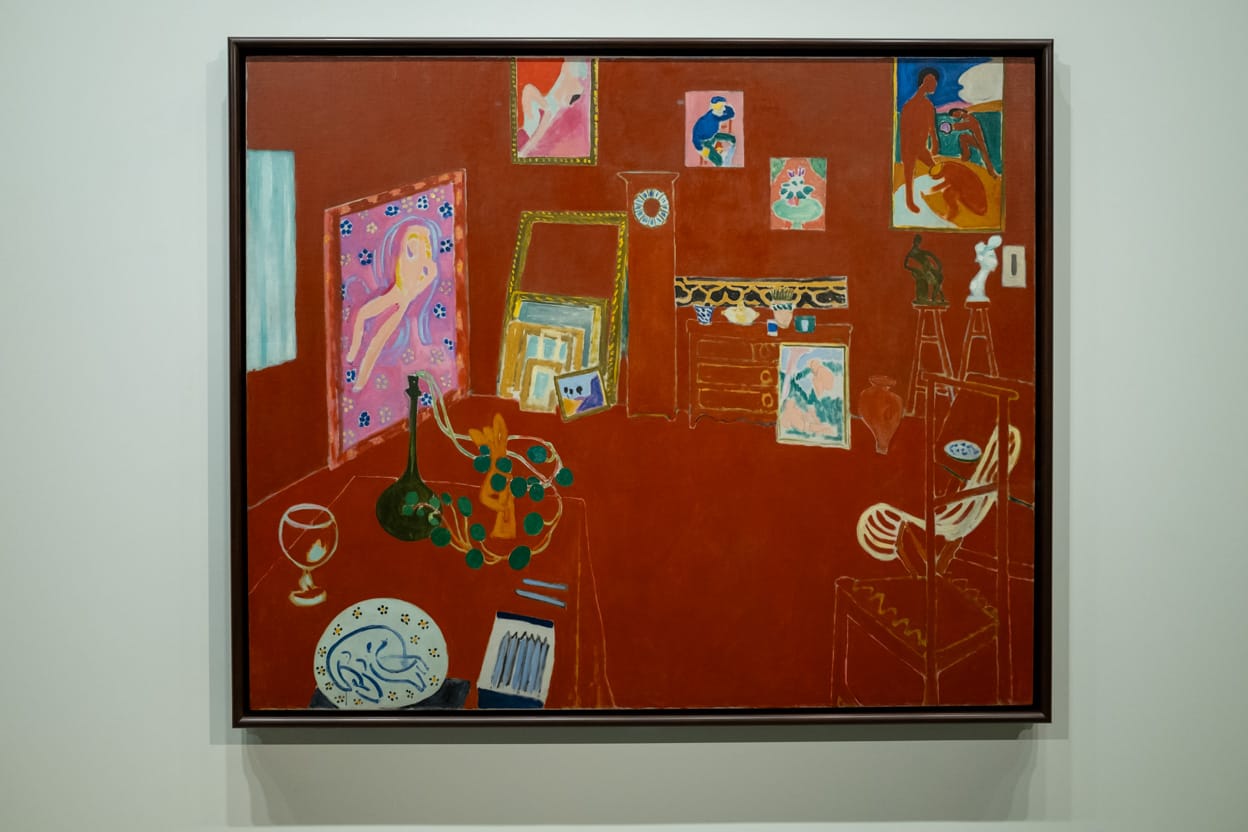
Henri Matisse’s "L’Atelier Rouge" (The Red Studio, 1911) is a fascinating painting with an equally fascinating history. It is widely regarded as a key work in Matisse’s oeuvre and indeed the history of modern art. The painting represents the artist’s studio in the Parisian suburb of Issy-les-Moulineaux, including 11 of Matisse’s own works from the previous 13 years as well as some furniture and other objects. At the last minute Matisse decided to overpaint the background in deep Venetian red, thereby all but obliterating perspective and flattening pictorial space leaving only the outlines of the furniture. As a consequence the objects seem to float in a space.
"The Red Studio" was originally commissioned by Sergei Shchukin, a wealthy Russian businessman and art collector, who championed the work of Cézanne, Derain, Matisse and Picasso. Shchukin had left the choice of subject to the artist, but when Matisse sent him a watercolor representing the finished painting, he refused to buy it, saying he preferred Matisse’s paintings with figures in it.
"The Red Studio" was first exhibited in London in 1912 as part of the second Post-Impressionist Exhibition. It then travelled on to the United States, where it was included in the Armory Show in New York, Chicago and Boston. However, it failed to attract a buyer. In 1927 it was acquired by the owner of a fashionable private nightclub in London. For the next 13 years the painting would adorn the wall of the club’s ballroom, visible only to London’s high society. At the end of the 1930s the club’s owner decided to sell "The Red Studio". It ended up, first at a gallery in London, where it remained until 1945, and then at a gallery in New York. By that time "The Red Studio" had been recognized as a masterpiece. In 1948, the gallery’s owner agreed to sell it to MoMA, where it was first shown to the public in 1949.
The exhibition Matisse: L’Atelier Rouge, previously shown at MoMA in New York and at the Statens Museum for Kunst in Copenhagen, brings together for the first time "The Red Studio" and all the paintings and objects depicted in it, except for “Grand Nu”, the large painting on the left, which at Matisse’s request was destroyed upon his death.
It is an absolute joy to see "The Red Studio" in all its glory surrounded by all surviving paintings represented in it, some of which are rarely exhibited. It is especially interesting to see how Matisse chose to paint his earlier works. "Baigneurs" (Bathers, 1907) as depicted in "The Red Studio" is representative of his later work. Matisse also chose to render the nudes in "Le Luxe II" (1907-08) in red, like the figures in "La Danse" (1909-10)
The exhibition is complemented by several other paintings by Matisse, including "La Fenêtre bleue" (The Blue Window, 1913) and "Poissons rouges et Sculpture" (Goldfish and Sculpture, 1912), from the collection of MoMA and "Grand Intérieur rouge" (1948) on loan from the Centre Pompidou.
Concurrently with Matisse: The Red Studio the Fondation Louis Vuitton has organized an Ellsworth Kelly retrospective. And so, upon entering you have to choose which exhibition to visit first. I chose to visit the Ellsworth Kelly retrospective first, but if I could do it all over again I would probably visit the Matisse show first. Either way, the Fondation Louis Vuitton is always crowded, unless you visit first thing in the morning or late in the afternoon on a Wednesday.
Matisse: L’Atelier Rouge is at the Fondation Louis Vuitton in Paris through 9 September 2024.